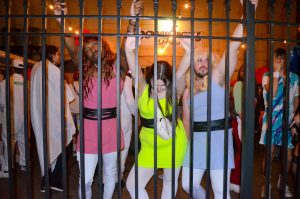Guest Column: Concealed carry on campus is a bad idea
October 17, 2011
Having moved to dramatically weaken collective bargaining for public employees and bankrupt local governments, the Ohio legislature has now set its sites on a new goal: allowing concealed weapons at Kent State and other colleges and universities in the state. House Bill 256, currently under consideration by the General Assembly, allows a person with a concealed weapon license to carry a gun in “public or private institutions of higher education, places of worship, day-care centers and homes and government buildings other than schools, courthouses, law enforcement offices, and correctional facilities.”
new TWTR.Widget({
version: 2,
type: ‘search’,
search: ‘#kwguns’,
interval: 6000,
subject: ”,
width: 240,
height: 300,
theme: {
shell: {
background: ‘#b8b8b8’,
color: ‘#66a9c5’
},
tweets: {
background: ‘#b8b8b8’,
color: ‘#444444’,
links: ‘#1985b5’
}
},
features: {
scrollbar: true,
loop: true,
live: true,
hashtags: true,
timestamp: true,
avatars: true,
toptweets: true,
behavior: ‘default’
}
}).render().start();
Now it seems to me that during one of the worst economic recessions in 70 years, worrying about whether students and faculty can pack heat during midterms or Greek parties seems a bit misplaced. In fact, I’ll go out on a limb to say that as a faculty member, father of two children and member of the Kent State community, I cannot think of many policies more insane than allowing students, faculty and staff to walk around campus 24/7 with loaded guns — concealed or otherwise. And the reasons are obvious.
Students at colleges and universities have been known to indulge a bit in drugs and alcohol. Stress, depression, risk of suicide and other mental issues are common on college campuses. There’s of course the reality of 25,000 students living in close proximity to one another creating opportunities for accidental shootings and thefts. And of course, let’s not forget Kent State’s own occasional block-party riots that seem to occur annually with the snow melt.
Now, Kent State will not suddenly transform into the Wild West or a scene out of “Boyz in the Hood” if HB 256 passes. On the 25 college campuses that allow concealed weapons there have not, as of yet, been reports of gun deaths or injuries. And I believe that individuals who take the time to get a concealed carry license are law-abiding, conscientious — albeit a little paranoid — citizens who would not harm anyone unless they felt threatened or insulted. Ok, I’m kidding about the second part of that last sentence.
But the thing is that — as we saw at Virginia Tech, the University of Alabama, Columbine, or recently in Norway, Fort Hood, Texas, and Phoenix, Arizona — guns make it really easy for one person to harm and kill a lot of people quickly. And the more guns floating around campus, the more likely it is for an accident to occur or some unbalanced person to commit a tragedy. And I guess that’s where the trigger meets the bullet or the hammer meets the slug or whatever the metaphor.
While I view the shootings at Virginia Tech or Columbine as examples of sick and angry people having to easy access to a gun, to the National Rifle Association or Students for Concealed Carry on Campus, these tragedies are precisely why we need more guns: Guns reduce the likelihood of gun violence on campus. If the 99 percent of law-abiding citizens are packing heat, the argument goes, we won’t have to worry about the crazy one percent.
The beauty of such an argument, from the perspective of a political scientist, is that it is irrefutable. No amount of evidence can undermine the argument of gun proponents. A decline in violence means we don’t need to worry about increased gun ownership. On the other hand, a spike in shooting can only mean there not enough people with guns to stop the violence. Heads I win, tales you lose.
In truth, once everyone is allowed to carry a favorite handgun or assault rifle at Kent State, we all lose.
Mark K. Cassell is an associate professor in political science here at Kent State.








